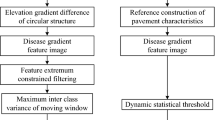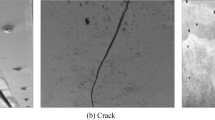Abstract
In order to realize the division of damage region accurately and efficiently, an aircraft surface damage region rapid division method is proposed in this paper. Gaussian convolution is introduced to realize the feature representation of damaged image by fusing the gray difference of neighborhood pixels represented by distance weight. Through the definition of the nearest pixel distance sum, the various structural damage morphologies are transformed into the common feature distribution, and based on this, the neighborhood Gaussian feature threshold division criteria is defined. Then, the one-way optimization algorithm is designed to realize the aircraft surface damage region rapid division. Finally, the method is verified by the aircraft surface damage image instances. The results show that compared with the gray entropy threshold division methods, the damage region obtained by the proposed method is complete, the damage region details are better preserved, and the influence of regional interference factors such as damage adjacent regions and brightness changes are eliminated. And the operation efficiency of the proposed method is obviously better than the multi-dimensional threshold method with similar division effect. For diversified damage image instances, when the optimization step is within the critical value, all the optimization operations can reach the optimal threshold. Thus, the aircraft surface damage region division is realized accurately and efficiently, which will provide the technical support for intelligent damage detection and damage analysis.

















































Similar content being viewed by others
Explore related subjects
Discover the latest articles and news from researchers in related subjects, suggested using machine learning.Data Availability Statement
All data generated or analysed during this study are included in this published article and its supplementary information files.
References
Bansal M, Kumar M, Sachdeva M, et al. (2021) Transfer learning for image classification using VGG 19 : Caltech-101 image data set. J Ambient Intell Humanized Comput, pp 1–12
Chakraborty F, Roy PK, Nandi D (2021) A novel chaotic symbiotic organisms search optimization in multilevel image segmentation. Soft Comput 25 (10):6973–6998
Chauhan S, Singh M, Agarwal AK (2019) Crisscross optimization algorithm for the designing of quadrature mirror filter bank. In: 2019 2nd international conference on intelligent communication and computational techniques (ICCT), pp 124-130
Fan R, Liu M (2020) Road damage detection based on unsupervised disparity map segmentation. IEEE Trans Intell Transp Syst 21(11):4906–4911
Fekri-Ershad S, Tajeripour F (2017) Multi-resolution and noise-resistant surface defect detection approach using new version of local binary patterns. Appl Artif Intell 31(5):395–410
Iskandarani MZ (2019) Effect of correlating image threshold values with image gradient field on damage detection in composite structures. Int J Adv Comput Sci Appl 10(4):242–251
Luo R, Zhang L (2021) Intelligent detection method for internal cracks in aircraft landing gear images under multimedia processing. Symmetry-Basel 13 (5):778–778
Pourkaramdel Z, Fekri-Ershad S, Nanni L (2022) Fabric defect detection based on completed local quartet patterns and majority decision algorithm. Expert Syst Appl 198:116827:1–10
Qin Z, Zhang Y, Zhang S, et al. (2019) Identification of microscopic damage law of rocks through digital image processing of computed tomography images. Traitement du Signal 36(4):345–352
Resma KPB, Nair MS (2021) Multilevel thresholding for image segmentation using Krill Herd Optimization algorithm. J King Saud Univ - Comput Inf Sci 33(5):528–541
Ronickom JFA, Sobhana AR, Robert F, et al. (2020) Automated damage detection and characterization of polymer composite images using Tsallis particle swarm optimization based multilevel threshold and multifractals. Polym Compos 41(8):3194–207
Shaheed K, Mao AH, Qureshi I, et al. (2022) Recent advancements in finger vein recognition technology : methodology challenges and opportunitie. Inf Fusion 79:84–109
Shaheed K, Mao AH, Qureshi I, et al. (2022) DS-CNN : a pretrained xception model based on depth-wise separable convolutional neural network for finger vein recognition. Expert Syst Appl 191:116288:1–18
Shaheed K, Mao AH, Qureshi I, et al. (2022) Finger-vein presentation attack detection using depthwise separable convolution neural network. Expert Syst Appl 198:116786:1–16
Ye Z, Li H, Zha W, et al. (2021) A Visual detection method of tool damage using local threshold segmentation . J Xi’an Jiaotong Univ 55:52–60
Zhang Y, Huang X, Jia J, et al. (2019) A recognition technology of transmission lines conductor break and surface damage based on aerial image. IEEE Access 7:59022–59036
Zhang T , Tian Y, Wang Z, et al. (2020) Adaptive threshold image segmentation based on definition evaluation. J Northeast Univ 41(9):1231
Funding
This work was supported in part by the Aeronautical Science Foundation of China (No.20151067003) and the Fundamental Research Funds for the Central Universities
Author information
Authors and Affiliations
Corresponding author
Ethics declarations
Competing interests
No potential conflict of interest was reported by the authors.
Additional information
Publisher’s note
Springer Nature remains neutral with regard to jurisdictional claims in published maps and institutional affiliations.
Rights and permissions
Springer Nature or its licensor (e.g. a society or other partner) holds exclusive rights to this article under a publishing agreement with the author(s) or other rightsholder(s); author self-archiving of the accepted manuscript version of this article is solely governed by the terms of such publishing agreement and applicable law.
About this article
Cite this article
Cai, S., Shi, L. An aircraft surface damage region rapid division method. Multimed Tools Appl 82, 28117–28142 (2023). https://doi.org/10.1007/s11042-022-14323-8
Received:
Revised:
Accepted:
Published:
Issue Date:
DOI: https://doi.org/10.1007/s11042-022-14323-8




